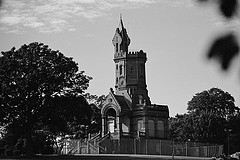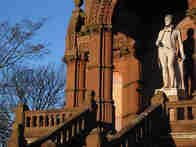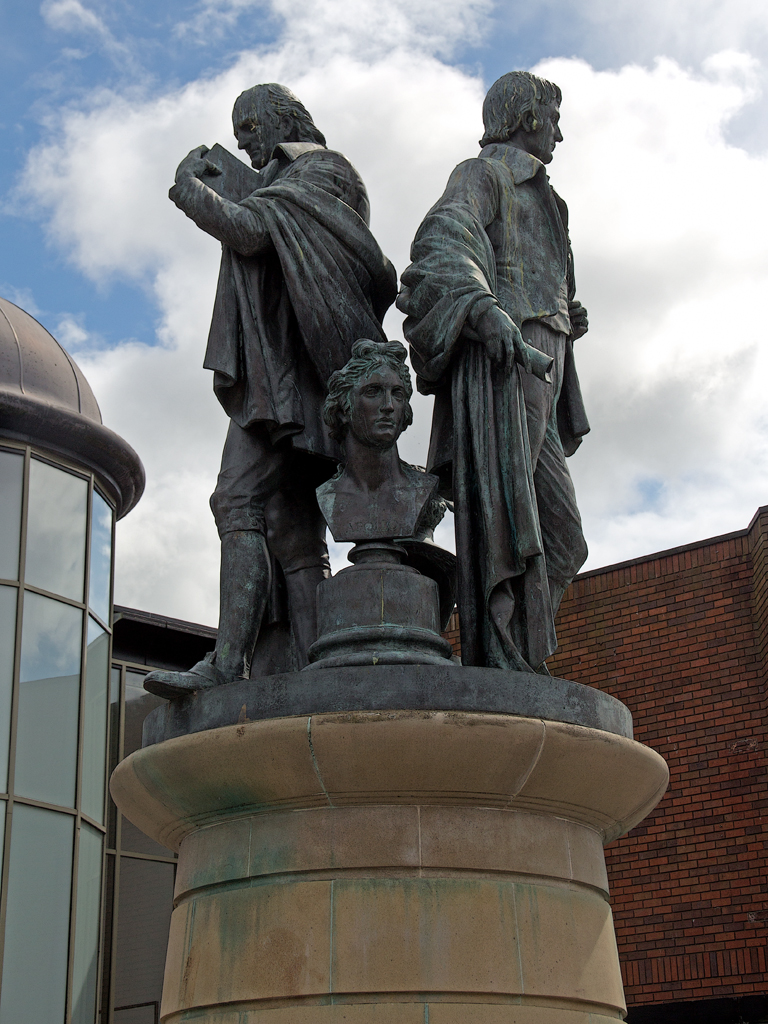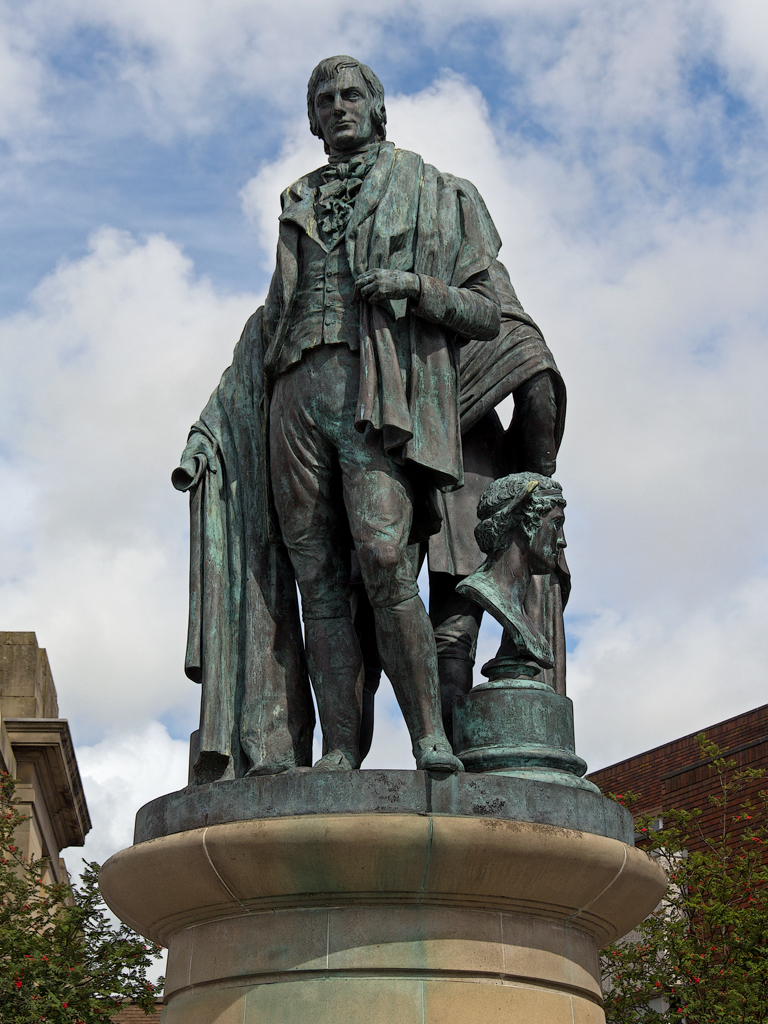|
Kilmarnock Monument

Photo by Paul Russell.
The campaign for a statue of Burns in Kilmarnock began in 1872 but it was not until 9th August 1879 that the monument was unveiled.
The chief protagonist in this scheme was James McVie who personally raised most of the £2,893 necessary for the erection of the impressive monument which stands in the Kay Park to this day.
Undoubtedly the most pretentious of all Burns monuments, this curious structure was designed by the Kilmarnock architect, Robert Ingram, and can best be summed up as an eclectic fusion of Scots Baronial, neo-Gothic and Italianate, with a dash of Baroque and a hint of Romanesque.
The 80-foot tower of red sandstone dwarfs the statue of the poet, of Sicilian marble eight feet tall.

Photo by Paul Russell.
The statue itself was chiselled by William Grant Stevenson (1849-1919) who also sculpted the colossal statue of William Wallace at Aberdeen and was noted for his statuary of historic personalities.
He made a study of the various authentic portraits of the poet and also used a cast of his skull when modelling the head. The result is very pleasing, and also the closest to the original Nasmyth bust. Burns is shown in the act of composition, with a pencil poised in his right hand while the left grasps a notebook resting against a tree-stump.
Like the Alloway and Gallon Hill monuments, the Kay Park extravaganza was intended as the repository of Burnsiana, in this case the fine collection of books, manuscripts and relics which had been assembled by Mr McKie. Sad to relate, the monument suffered fire damage but fortunately the McKie collection had been removed to the greater safety of Dean Castle and the Dick Institute.
Stevenson had been the winner of a competition to find the most suitable design for a statue. His brother David was awarded a prize of £50, while William McBryde got £25. The models for the statues by the Stevenson brothers and McBryde were thus acquired by the monument committee and were displayed at the Centenary Exhibition in 1896.
So far as can be ascertained, the McBryde model was never subsequently realised in any form, but W.G. Stevenson also carved at least one copy of his statue, and this was exhibited in the place of honour at the Centenary celebration. D.W. Stevenson's model was subsequently executed full-scale and casts were erected in Leith, Newcastle upon Tyne and Toronto.
The three models from the competition were until recently on display inside the Kilmarnock monument but have now been removed temporarily to Dean Castle. Probably the most distinguished sculptor to turn his hand to the subject of Burns was Sir John Robert Steell (1804-91). The son of an Aberdeen wood carver of the same name, he himself was apprenticed to a wood-carver but also studied at the Trustees Academy, where he came to the attention of George Thomson. Later he won a scholarship which enabled him to spend several years studying in Rome.
Following his return to Scotland he received many public commissions. His marble figure of Sir Walter Scott for the memorial in Princes Street, Edinburgh was the first marble statue to be commissioned from a native Scot. He was appointed Sculptor to the Queen in Scotland and at the unveiling of his memorial to the Prince Consort in 1876 he was knighted by Queen Victoria. Although pre-eminent as a carver of marble statuary he also introduced the technique of bronze-casting to Scotland and established his own foundry, which was subsequently used by most Scottish sculptors of the period.
The most recent statue to Burns unveiled by the HRH The Princess Royal on 27th September 1995 stands at Kilmarnock Cross and depicts Burns and Wilson, the printer of the Kilmarnock Volume.
The credits for this monument are –
David Page who had the original conception of erecting a statue at Kilmarnock Cross.
The architect David McAllister, Associate, Page and Park Architects.
Ian Cumming, Stone Mason, cut the plinth from Black Pasture Stone.
Morris Singer Foundry, Basingstoke, cast the bronze.
Kilmarnock Monument

The figures of Burns and Wilson face in opposite directions.
This is to assert the crucial position of Kilmarnock in the forging of Burns as the National Poet of Scotland. For Burns faces south west, into the Ayrshire heartland, the setting of his eclogue: Wilson faces north-west, towards Edinburgh, the capital city of Scotland.
It was by means of Kilmarnock's agency that Burns came to the national attention, therefore the printer of that famed edition of verse is given the conveying position in the group for it is, emphatically, Wilson's Monument.
Here was a man who had published Virgil in Kilmarnock, as well as other ploughmen poets, like Burns, and Lapraik, and sold editions in his bookshop in the town, as an arbiter of literary taste.
To the south-east the bust of Hermes ( the God of all communication ) gazes towards the location of European culture's origins. A further conveyance is intoned here; that of the classical tradition of Pastorale, brought to here (or sent from here) by the god of messages and news: the publisher's god.
Gazing north-west, the Grecian deity most frequently associated with the extreme north of Europe, Apollo, ( the God of Lyric Poetry ) the Hyperborean, accompanies the lyric poet, to verify his grace and his grandeur.
All this was but a further carving of compass-points upon a bark, that our position might not be lost, nor our ancient habits neglected.
Kilmarnock Monument

|
| |
